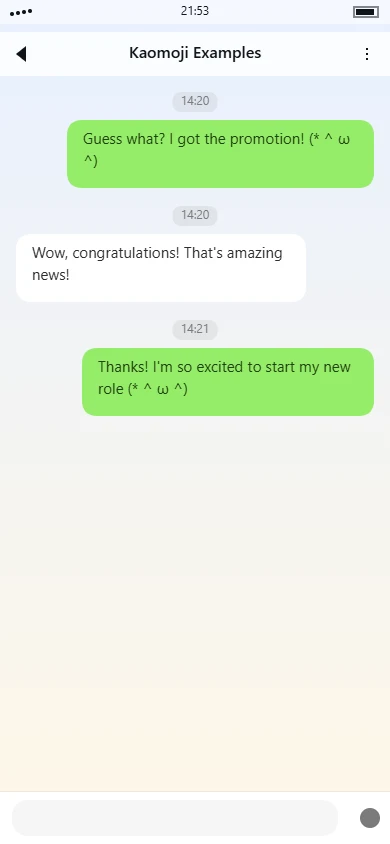(´。• ω •。`) kaomoji meaning | usage tips

Overview
This kaomoji (´。• ω •。`) presents a gentle, shy facial expression through a carefully arranged sequence of characters. The overall structure uses curved parentheses to frame the face, with dot accents and a central omega-like character creating a soft, approachable appearance.
Visual Structure Explanation
The kaomoji employs a symmetrical design with opening and closing curved parentheses (´ and `) serving as the facial outline. Within this frame, the eyes are represented by dot characters (•) placed on either side of a central omega-like character (ω). The dots preceding the eyes (。) add subtle decorative elements that soften the overall expression. The spacing between characters creates a balanced composition where the eyes appear slightly lowered, contributing to the shy or modest impression.
Symbol Breakdown
- Curved parentheses (´ `): These symbols frame the face with gentle curves, creating a rounded facial contour that suggests a soft, non-threatening expression
- Small ideographic full stops (。): Positioned before the eyes, these tiny dots function as decorative accents that add detail to the cheeks or facial periphery
- Bullet operators (•): Serving as the main eyes, these solid circular symbols provide clear focal points while maintaining a simple, clean appearance
- Greek small letter omega (ω): This character forms the mouth area, with its curved shape suggesting a small, closed-mouth smile or neutral expression
- Spacing arrangement: The strategic placement of characters creates visual hierarchy, with the eyes positioned slightly above the mouth area in a natural facial proportion
Emotion & Aesthetic Analysis
The emotional tone conveyed by this kaomoji leans toward shyness, modesty, or gentle contentment. The downward-facing eyes created by the bullet operators, combined with the small omega mouth, produce an expression that could be interpreted as bashful, quietly pleased, or slightly reserved. Compared to more exuberant kaomoji with wide-open eyes or exaggerated smiles, this version maintains a restrained quality.
In terms of aesthetic style, the kaomoji demonstrates a preference for clean, minimalist character choices rather than complex symbol combinations. The use of mathematical and Greek characters alongside Japanese punctuation creates a hybrid visual language that feels both technical and expressive. The overall effect is understated rather than dramatic, making it suitable for situations requiring subtle emotional signaling rather than strong emphasis.
Tag categories
Use tags to quickly understand this kaomoji.
Expression tags
Click tags to explore related kaomoji.
Usage guide
Understanding (´。• ω •。`)
This gentle kaomoji captures a moment of soft, heartfelt emotion—think of someone with slightly downturned eyes, a small smile, and an expression that's both tender and slightly vulnerable. It's perfect for conveying warmth, affection, or quiet happiness in digital conversations, often used when you want to express gratitude, shyness, or a touch of sentimental feeling without being overly dramatic. The rounded cheeks and the small mouth give it a distinctly cute, almost bashful quality, making it ideal for personal messages, lighthearted exchanges, and situations where you want to soften your tone.
Use Cases
- Sending a thank-you message to a friend who helped you with a small favor
- Reacting to a cute pet photo shared in a group chat
- Expressing modest happiness when someone compliments your work
- Responding to a kind gesture from a family member
- Showing gentle appreciation for a thoughtful message
- Conveying shy excitement about plans with close friends
- Reacting to heartfelt stories or sentimental moments online
- Softening a request to make it sound more polite and considerate
- Expressing quiet contentment after a relaxing day
- Showing affectionate support to someone sharing personal news
- Responding to romantic messages with tender feelings
- Adding warmth to casual goodnight wishes
Examples
-
Friend: "I saved you a slice of cake from the party!"
You: "Aww, thank you so much! (´。• ω •。`)" -
Partner: "Thinking of you today ❤️"
You: "That means a lot... (´。• ω •。`) me too" -
Family member: "Your graduation photos came out beautiful!"
You: "Thank you for saying that (´。• ω •。`) I was so nervous" -
Colleague: "Great job on the presentation today!"
You: "I'm really glad you liked it (´。• ω •。`) thank you" -
Online friend: "I made this digital art inspired by your story"
You: "This is so touching (´。• ω •。`) I love it"
Notes
- Avoid using this kaomoji in formal emails or professional contexts where clear, straightforward communication is expected—its emotional nuance might come across as unprofessional or too casual.
- While generally positive, the shy, vulnerable quality of this expression might be misinterpreted as sadness or hesitation in some contexts, so consider your relationship with the recipient.
- In cultures where direct communication is valued, this subtle expression might not convey your message strongly enough—it works best in relationships where emotional nuance is appreciated.
This kaomoji is particularly popular on platforms like Discord, Twitter, and personal messaging apps where users value expressive, nuanced communication. Its gentle nature makes it perfect for building rapport and showing emotional intelligence in digital conversations.
Usage examples
Real conversation samples that feature this kaomoji.

Example 1

Example 2
Related kaomoji
You might also enjoy these kaomoji.